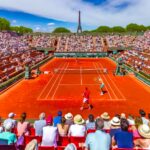Introduction to Paris Plages
Every summer, the city of Paris hosts an event that many people find delightful: Paris Plages. Despite its name suggesting a distant, exotic location, Paris Plages is actually within the city itself. The initiative transforms certain areas along the Seine River and the Bassin de la Villette into temporary beaches complete with sand, deck chairs, and various recreational activities.
Historical Context and Origins
Paris Plages was first introduced in 2002 under the leadership of former Paris mayor Bertrand Delanoë. The idea was to provide both locals and tourists with a chance to enjoy the feeling of being on a beach without having to leave the urban environment. This concept was born from a vision to make use of the unique Parisian landscape, especially the Seine, in a way that promoted leisure and cultural activities. The event quickly gained popularity and has become a summer staple ever since, demonstrating a blend of innovation in urban planning and cultural enrichment.
The Evolution Over the Years
Since its inception, Paris Plages has grown significantly in both scale and offerings. Initially focused along the Seine’s Right Bank, it expanded to include the Left Bank and the Bassin de la Villette. This evolution reflects the constant efforts to enhance the visitor experience with new activities and amenities. Various partnerships with cultural institutions and artists have been established, providing an ever-changing canvas of events that keep the initiative fresh and exciting each year.
Main Features of the Event
Paris Plages is typically open from mid-July to early September. There are several sections to explore, each offering its own unique attractions and activities. The transformation of these areas into pedestrian-friendly zones adds to the appeal and accessibility of the event.
Seine Riverbank
The transformation of the Seine Riverbank into a pedestrian-friendly space is one of Paris Plages’ most remarkable achievements. Visitors can enjoy the iconic view of the Seine, coupled with a range of activities to suit diverse interests. The area often includes concerts, which showcase both local and international talent, dance lessons to engage participants, and art exhibitions that provide cultural enrichment. Sand and palm trees contribute to the ambiance, offering a beach-like experience that contrasts with the urban setting. These elements not only enhance leisure but also foster a sense of community among visitors.
Bassin de la Villette
The Bassin de la Villette becomes the hub for more energetic activities such as kayaking and paddleboarding. These water sports are particularly appealing for those looking to engage in physical activities, providing both fun and fitness. Additionally, the Bassin offers options for those who prefer relaxation over exertion. Sun loungers and shaded areas provide spaces to unwind, where one can enjoy a book or simply bask in the summer sun. This combination of active and passive recreational opportunities makes the Bassin de la Villette a versatile destination during Paris Plages.
Cultural and Recreational Activities
Beyond the primary attractions at the Seine Riverbank and the Bassin de la Villette, Paris Plages offers a variety of cultural and recreational activities that broaden its appeal. These initiatives often include workshops, interactive performances, and educational sessions aimed at various age groups. Collaborations with museums and local artists result in innovative programs that engage attendees in novel experiences, enriching their visit through diverse cultural expressions.
Workshops and Classes
Workshops on various topics, ranging from art to environmental conservation, are regularly held during Paris Plages. These sessions allow participants to learn new skills and gain insights into specific subjects, contributing to personal development and awareness. Whether it’s a painting class or a seminar on sustainable living, these offerings foster community interaction and learning.
Interactive Installations
Interactive installations and exhibits along the riverbank and the Bassin are a testament to the collaboration between artists and organizers. These art pieces not only beautify the area but also engage visitors in thoughtful contemplation and dialogue. Through interactive displays, participants are encouraged to explore themes such as urban living, environmental challenges, and cultural heritage.
Sustainability and Environmental Considerations
While the event is meant to mimic the beach experience, it’s important to note that Paris Plages places emphasis on maintaining an environmentally-friendly setting. The use of sustainable materials in temporary structures is a reflection of the city’s commitment to ecological responsibility. Organizers often run campaigns on waste reduction, recycling, and water conservation, making these issues visible to the numerous attendees who might be inspired to implement similar practices in their own lives.
Environmental Education
Educational initiatives related to environmental awareness are commonly integrated into the event. These could include workshops on topics such as the importance of recycling, energy efficiency, and biodiversity. The aim is to educate the public on the small changes they can make in everyday life to contribute to the planet’s health, reinforcing the event’s broader goal of sustainability.
Greener Practices
Paris Plages is an exemplar of how large-scale urban events can implement greener practices. By prioritizing sustainable materials and renewable energy sources in its setup and operations, the event showcases practical approaches to reducing carbon footprints. This focus not only aligns with global sustainability goals but also sets a benchmark for similar events worldwide.
Accessibility and Participation
Paris Plages is accessible to everyone and free of charge, a feature that significantly contributes to its widespread popularity among both Parisians and tourists. This accessibility ensures that individuals from all walks of life can participate, creating an inclusive atmosphere that reflects the city’s cultural diversity.
Inclusive Facilities
Efforts are made to ensure facilities are accessible to individuals with disabilities, including ramps and designated seating areas. Such measures enable everyone to fully enjoy the offerings of Paris Plages, highlighting the city’s commitment to inclusivity.
Volunteer Opportunities
The event also provides numerous volunteer opportunities, allowing individuals to contribute to its success. Volunteers assist in a range of functions from guiding visitors to organizing activities, enhancing the overall experience for everyone involved.
Conclusion
While this urban “beach” is quite different from any natural beach, it embodies a clever urban adaptation, offering city dwellers a moment of natural indulgence right in the heart of Paris. The success of Paris Plages illustrates how human-centered events can coexist with urban landscapes while maintaining environmental mindfulness. For more information on Paris Plages and to check for any updates or events, you can visit the official Paris City Hall website. This resource will provide you with the latest details about the event in case you plan to experience it in person.









